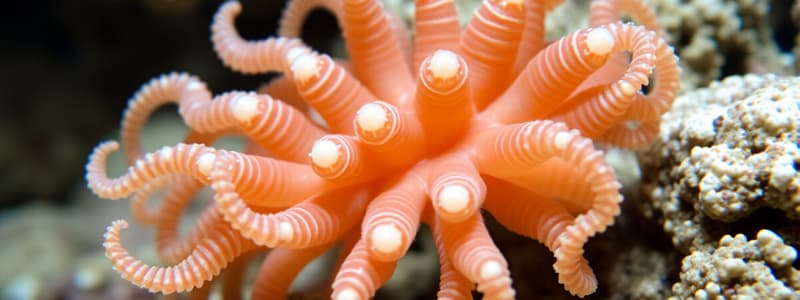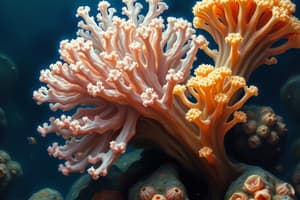Podcast
Questions and Answers
What is the free swimming larva form of certain oviparous species called?
What is the free swimming larva form of certain oviparous species called?
- Ciliated larva
- Planktotrophic larva
- Parenchymula (correct)
- Eudoxid larva
What unique cell type is characteristic of the phylum Cnidaria?
What unique cell type is characteristic of the phylum Cnidaria?
- Flagellated cells
- Nematocysts
- Cnidocytes (correct)
- Choanocytes
How long is the fossil history of Cnidarians believed to span?
How long is the fossil history of Cnidarians believed to span?
- 3 billion years
- 1 million years
- 100 million years
- 700 million years (correct)
In what type of habitats are most Cnidarians found?
In what type of habitats are most Cnidarians found?
What is a notable characteristic of colonial hydroids in terms of their habitat?
What is a notable characteristic of colonial hydroids in terms of their habitat?
Which of the following describes how Cnidarians prey on other organisms?
Which of the following describes how Cnidarians prey on other organisms?
How do some organisms utilize the stinging cells of Cnidarians for their own benefit?
How do some organisms utilize the stinging cells of Cnidarians for their own benefit?
In the context of mutualism, how do anemones benefit from living on hermit crab shells?
In the context of mutualism, how do anemones benefit from living on hermit crab shells?
Which class of cnidarians is known as the true jellyfish?
Which class of cnidarians is known as the true jellyfish?
What type of body form do polyps exhibit?
What type of body form do polyps exhibit?
What is a key advantage of the dimorphism seen in some cnidarians?
What is a key advantage of the dimorphism seen in some cnidarians?
Which cnidarian class is recognized for its variety of living forms, including hydroids and fire corals?
Which cnidarian class is recognized for its variety of living forms, including hydroids and fire corals?
What is a distinguishing feature of cubozoans?
What is a distinguishing feature of cubozoans?
What type of symmetry do hexacorallians exhibit?
What type of symmetry do hexacorallians exhibit?
Nematocysts play a critical role in which aspect of cnidarian biology?
Nematocysts play a critical role in which aspect of cnidarian biology?
What characteristic is typical of the medusa form of cnidarians?
What characteristic is typical of the medusa form of cnidarians?
How do sea anemones primarily trigger feeding behavior?
How do sea anemones primarily trigger feeding behavior?
Which class contains both hard corals and sea anemones?
Which class contains both hard corals and sea anemones?
Which of the following statements about the class Anthozoa is correct?
Which of the following statements about the class Anthozoa is correct?
What is the size range of sea anemones?
What is the size range of sea anemones?
What is the significance of chitin-like material in nematocysts?
What is the significance of chitin-like material in nematocysts?
Which subclass of Anthozoa features soft and horny corals?
Which subclass of Anthozoa features soft and horny corals?
What is unique about the polyp of the species Tripedalia cystophora?
What is unique about the polyp of the species Tripedalia cystophora?
How do sea anemones typically attach to their environment?
How do sea anemones typically attach to their environment?
What is the main advantage of the skin mucus for Nomeus fish in relation to the Portuguese man-of-war?
What is the main advantage of the skin mucus for Nomeus fish in relation to the Portuguese man-of-war?
What is the primary composition of the bell in true jellyfish of the class Scyphozoa?
What is the primary composition of the bell in true jellyfish of the class Scyphozoa?
Which process describes the formation of saucer-shaped buds in the life cycle of Scyphozoa?
Which process describes the formation of saucer-shaped buds in the life cycle of Scyphozoa?
What distinguishes the nervous system of Scyphozoa from that of hydrozoans?
What distinguishes the nervous system of Scyphozoa from that of hydrozoans?
Which of the following statements is accurate regarding the reproductive process of true jellyfish?
Which of the following statements is accurate regarding the reproductive process of true jellyfish?
What is the typical size range for the medusae of box jellyfish in the class Cubozoa?
What is the typical size range for the medusae of box jellyfish in the class Cubozoa?
What evolutionary characteristic differentiates Scyphozoa from other less advanced groups?
What evolutionary characteristic differentiates Scyphozoa from other less advanced groups?
How do the tentacles of the Portuguese man-of-war primarily function?
How do the tentacles of the Portuguese man-of-war primarily function?
What triggers the discharge of a nematocyst in cnidarians?
What triggers the discharge of a nematocyst in cnidarians?
Which class does Obelia belong to within the cnidarian phylum?
Which class does Obelia belong to within the cnidarian phylum?
What is the role of cnidocytes in cnidarians?
What is the role of cnidocytes in cnidarians?
What distinguishes the neural net of cnidarians from that of more complex animals?
What distinguishes the neural net of cnidarians from that of more complex animals?
What happens after partial extracellular digestion in the feeding polyp of Obelia?
What happens after partial extracellular digestion in the feeding polyp of Obelia?
Which of the following statements about nematocysts is true?
Which of the following statements about nematocysts is true?
What reproductive process occurs when Obelia buds off a gonangium?
What reproductive process occurs when Obelia buds off a gonangium?
How do cnidocytes differ during development?
How do cnidocytes differ during development?
Flashcards are hidden until you start studying
Study Notes
Reproductive Characteristics
- Oviparous species release sperm and eggs into water currents.
- Larval stage known as parenchymula is free-swimming and flagellated.
- After settling, larval flagellated cells transform into choanocytes.
Phylum Cnidaria
- Contains over 9,000 species and includes organisms like jellyfish, sea anemones, and corals.
- Named after cnidocytes which harbor stinging organelles called nematocysts.
- Cnidarians have the longest fossil history, dating back approximately 700 million years.
- Predominantly marine, with a few freshwater species; most are sessile or slow-moving but are efficient predators.
Habitat and Distribution
- Abundant in shallow marine waters, especially in warm, tropical regions; no terrestrial species exist.
- Colonial hydroids settle on shells, rocks, and manmade structures in shallow waters.
- Free-swimming medusae are found in open seas and lakes.
Symbiotic Relationships
- Cnidarians often engage in symbiotic relationships; for example, hydroids may provide protection to hermit crabs and obtain food from them.
- Algal cells within cnidarians (notably reef-building corals) assist with nutrient acquisition.
Economic Importance
- While many cnidarians lack significant economic value, reef-building corals are critical for fishing, tourism, and marine trade.
Classification of Cnidarians
- Four primary classes:
- Hydrozoa (hydroids, fire corals, Portuguese man-of-war)
- Scyphozoa (true jellyfish)
- Cubozoa (box jellyfish)
- Anthozoa (sea anemones, stony and soft corals)
Morphological Types
- Two main forms: Polyp (sessile) and Medusa (free-swimming).
- Polyp examples include sea anemones, which do not have a medusae stage.
- Medusae have bell-shaped bodies and a more prominent role in certain life cycles.
Nematocysts
- Over 20 types exist; structure includes a coiled thread or filament enclosed in a capsule.
- Cnidocytes, which contain nematocysts, respond to tactile stimulation, allowing for prey capture or defense.
Nervous System
- Cnidarians exhibit neural nets, lacking a centralized nervous system, suited for their radial symmetry.
- Nerve cells exhibit unique features such as neurotransmitter release on both sides of a synapse.
Class Specifics
- Class Hydrozoa: Includes colonial forms like Obelia that exhibit both polyp and medusa stages; diverse feeding strategies.
- Class Scyphozoa: Features jellyfish, with complex locomotion and a two-stage life cycle from fertilized egg to medusa.
- Class Cubozoa: Box jellyfish are potent predators; life cycles include an inconspicuous polyp stage.
- Class Anthozoa: Exclusively polyp; includes varied forms from vibrant sea anemones to complex coral structures.
Feeding and Behavior
- Sea anemones are carnivorous, capable of consuming small fish and plankton.
- Movement is achieved through contraction of well-developed muscles; they react to environmental stimuli.
Studying That Suits You
Use AI to generate personalized quizzes and flashcards to suit your learning preferences.





